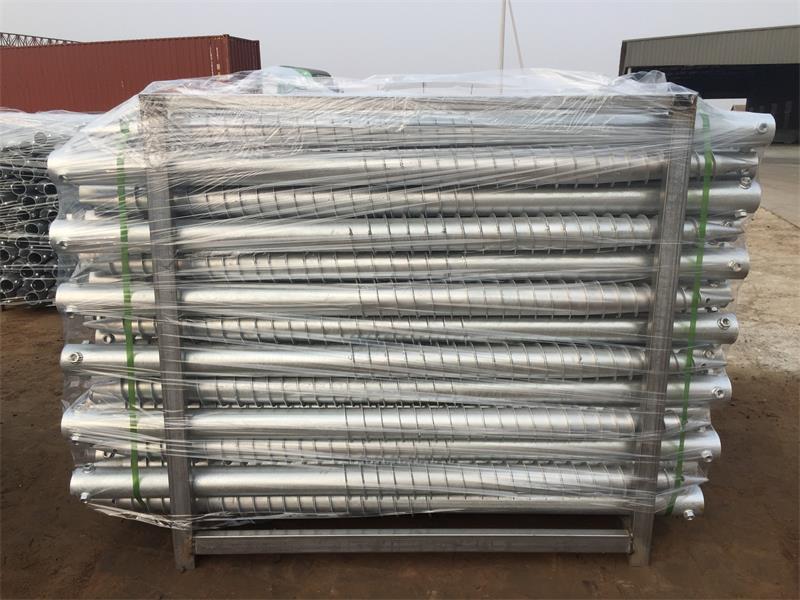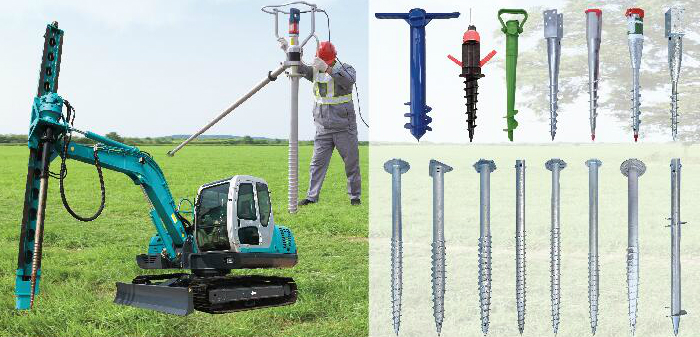Solar Energy System Nut Ground Screw
The hot dip Galvanized Ground Screw foundation for solar energy system , PV Mounting system .Our Ground screw made of Q 235 carbon steel with good quality .
Nut Ground screw with 3 pieces or 6 pieces customed nut to adjust the height of Ground screw for solar panel ,with reinforced plate to install the Ground screw ,it is easy to install ,and no harm to environments ,save time and cost .
with one or two or three big blades ,or continuous small thread . Big blade Nut Ground screw suitable for soft soil condition ,continuous small thread Nut Ground screw suitable for hard or mideum soil condition .They are installed perfectly perpendicular at the exact point within minutes .
Nut Ground screw size some like below : 76*3*1200mm with 3M16,76*3.5*1400mm with 3M16,76*3.5*1600mm with 3M16,76*3.5*2100mm with 3M16 nut .89*3.5*1400mm with 3M16 nut .& .
Advantage : easy install by spiral piling machine , no digging , no concrete , no waiting , much convenient , cost effective , save time , no need concrete foundation , suitable for different soil.
Nut Ground screw can be used in many fields,such as solar energy,petroleum and gas projects,building house,bridge,building temporary container house&
Helical Piers,Ground Screw Piles,Steel Ground Screw,Galvanized Ground Screw BAODING JIMAOTONG IMPORT AND EXPORT CO., LTD , https://www.chinagroundscrew.com

Artificial intelligence is becoming the driving force of the new era _ changing the world in the next 100 years
Artificial intelligence is set to transform society in the next century, much like electricity revolutionized industry over the past 100 years. Today, AI is already embedded in home robots, self-driving taxis, and mental health chatbots. Startups are pushing the boundaries of AI technology, aiming to develop machines that approach human-level intelligence. From powering digital assistants like Siri and Alexa to enabling more accurate online shopping and task automation, AI has become a part of everyday life.
At the AI Frontier Conference in Silicon Valley, Dr. Andrew Ng, co-founder of Coursera and a Stanford professor, emphasized that AI is akin to a new form of electricity. Just as electricity transformed every major industry a century ago, AI now holds the potential to reshape all sectors in the coming years. Though AI may seem like a recent innovation, it has been around for decades, but its rapid growth is fueled by advancements in data and computing power.
Most AI value comes from supervised learning, where algorithms learn from labeled datasets. The first wave involved predicting consumer behavior, such as ad clicks. The second wave emerged with complex tasks like speech recognition and image processing, where outputs go beyond numbers to include language and visual understanding. For example, autonomous vehicles use computer vision to interpret road conditions and navigate safely.
Microsoft’s Xudongdong highlighted how deep learning has enabled AI systems to match human performance in speech recognition. In 2016, Microsoft achieved a 5.9% error rate, matching human transcriptionists. Since then, this rate has dropped further, showing significant progress in AI capabilities.
Digital assistants like Siri and Alexa have evolved significantly since 2010. While their accuracy is now taken for granted, improving context understanding remains key. For instance, when a user asks Alexa what to do for dinner, the assistant must determine if they want a restaurant reservation, meal order, or recipe suggestion. Google's Dilek Hakkani-Tur pointed out that future AI will need to handle more nuanced conversations, including multi-domain tasks and deeper contextual understanding.
Beyond speech, computer vision plays a crucial role in AI. Facebook's Lumos system helps classify videos and images, identifying actions like "going out" based on gestures. Google's Rahul Sukthankar emphasized the importance of understanding the core meaning of video content, using YouTube examples to train AI models effectively.
E-commerce platforms like Taobao leverage AI to enhance shopping experiences. Users can upload images to find similar products, while Alibaba uses AR/VR to create immersive shopping environments. Additionally, Alibaba is exploring ways to insert virtual objects into user-generated videos, aiming to boost revenue for video platforms like Youku.
Despite progress, AI still falls short of human cognitive abilities. Vicarious, a startup focused on bridging the gap between AI and human intelligence, develops robots with advanced perception. Co-founder Dileep George argues that current AI resembles the "old brain" of mice, while the goal is to achieve the more complex "new brain" seen in primates. Vicarious uses deep learning to improve robot adaptability, allowing them to perform tasks even under changing conditions.
Robots like Kuri offer companionship and practical assistance. Equipped with HD cameras, depth sensors, and AI-driven navigation, Kuri can recognize people, pets, and environments. It also features a unique "Instant Choice" function to filter and organize recorded videos. Designed as a family companion, Kuri provides entertainment and home monitoring, available for $799.
Businesses are increasingly investing in AI, with the U.S. and China leading global efforts. McKinsey reports that North America invested between $15 billion and $23 billion, while Asia, mainly China, invested $8–$12 billion. Despite high investment, only 20% of companies have implemented AI effectively. Challenges include low ROI, limited business value, and a lack of skilled personnel.
Early adopters, such as tech and financial firms, integrate AI into core operations, focusing on innovation rather than cost-cutting. Meanwhile, industries like healthcare and education lag behind. However, experts believe AI adoption will accelerate as the technology becomes more accessible and impactful.